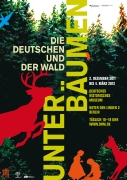

Forest Rescues
Under the impression of industrialization and increasing urbanization towards the end of the 19th century, people’s view of nature began to change. It was no longer perceived as an eerie wilderness or a commercially exploitable natural area, but rather as a basis of existence worthy of protection.
In the time before 1914 the supposedly wild, primordial forest, but also individual centuries-old trees, began to be seen as the epitome of “pristine nature”. Old trees came to be thought of as “natural monuments”. In this same period the forests in Germany became more important as places of recreation.
After Germany’s defeat in the First World War the conservation movement began to take on nationalistic undertones. Yet despite its proximity to National Socialism, environmental protection continued to develop in both German states after 1945. In East Germany conservation was partly directed against the state, while a strong ecology movement developed in the West.
